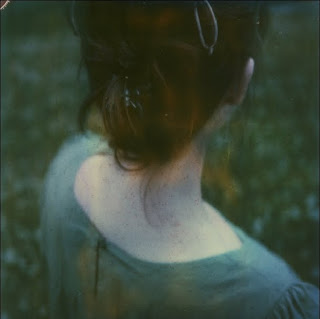Every artist is a cannibal
Lieselotte
Falling at your feet
Portrait of a girl
- Can you tell us something about yourself? When did you discover your passion for photography and polaroid?
Born 1973, I grew up in a small village in the province of Nordrhein-Westfalen, Germany. My grandfather had a little chemist's shop and after closing at 6.00 pm he disappeared in the shop's darkroom to develop all the films the customers had left on that day. This room was a strict "No-Children-Zone" and therefore everything that happened behind the door was a big mystery to me. And there was more to it than that! When the door opened again, voilá, lots of photographs hanging on the line! Could something be more desirable? How happy was I when I got my first camera, my grandfather's old Agfamatic 5008 macro pocket. That's where the story began. After quite some photographs I ended up in Berlin. Here I stumbled upon polaroids and a Polaroid SX-70 Landcamera-Alpha-1. When I took my first polaroids in October 2005 I knew I was lost, and now: for me it is all about polaroiding.
- How do you create your works?
Sometimes I do not see much for a long period. But some days there are things that just take my breath away. That's when I feel my heart pounding while getting my SX-70 ready for shooting. And then it's just "pulling the trigger" and of course: no digital strings attached!
- What are your main sources of inspirations?
Things I see, people I meet, places I go, books I read, music I am listening to: it's just daily life.
- What is the work that you are more attached? Why?
I admire the work of lots of different photographers like e.g. Saul Leiter, Richard Avedon, Leonard Freed, Robert Lebeck or Peggy Sirota. But I also love some photographs of more unpopular artists like Franck Juery, Ivan Wentland, Cyrille Panchot, Tod Brilliant, Thomas Ville, I-Nan Kuo, Urizen Freaza and many others. I do not prefer a special photographic style or a material used. It is important to me that a picture reflects the personal and distinctive photographer's handwriting. A good photograph can be technically a catastrophe as long as it catches the right moment. It has to address your emotions, that's the point. And last but not least: a photograph I am attached to could be everything but digital.
-Ci puoi raccontare qualcosa su di te? Quando hai scopert la tua passione per la fotografia e le polaroid?
Nato nel 1973, sono cresciuto in un piccolo villaggio nella provincia di Nordrhein-Westfalen, in Germania. Mio nonno aveva una piccola drogheria e tutte le sere, dopo aver chiuso alle 6, scompariva nella camera oscura per svilluppare i rullini che i clienti gli avevano portato quel giorno. In quella stanzai bambini non potevano entrare e così tutto ciò che succedeva al di là della stanza rappresentava un grosso mistero per me. E c’era di più. Quando la porta si apriva di nuovo, voilà, ecco che comparivano un sacco di fotografie! Può qualcosa essere più desiderabile? Quanto fui felice quando ricevetti la mia prima maccchina fotografica, la Agfamatic 5008 vecchia di mio nonno. Così p come è iniziata la storia. Dopo aver fotografato per un po’ finii a Berlino. É qui che mi sono imbattuto nelle Polaroid e più precisamente una Polaroid SX-70 Landcamera-Alpha-1. Quando comprai la mia prima polaroid nel 2005, sapevo di essere perso e ora: per me esiste solo la polaroid.
- Come crei i tuoi lavori?
Certe volte non vedo nulla per un lungo periodo, ma ci sono certi giorni in cui mi imbatto in cse capaci di togliermi il respiro. Questo succede quando sento il martellio del mio cuore mentre prendo la macchina pronta per scattare. Dopo è solo una questione di scatto, e ovviamente non uso niente di digitale.
-Quali sono le tue principali fonti d’ispirazione?
Cose che vedo, persone che incontro, posti che visito, libri che leggo, musica che ascolto: è semplicemnte vita quotidiana!
-Quali artisti predilige? Perchè?
Apprezzo i lavori di molti fotografi, come: Saul Leiter, Richard Avedon, Leonard Freed, Robert Lebeck e Peggy Sirota. Ma mi piacciono anche le fotografie di artisti meno popolari, come: Franck Juery, Ivan Wentland, Cyrille Panchot, Tod Brilliant, Thomas Ville, I-Nan Kuo, Urizen Freaza e molti altri. Non prediligo uno stile fotografico in particolare o un particolare tipo di materiale utilizzato. La cosa importante è che la fotografia rifletta lo stile personale dell’autore. Una fotografia può essere tecnicamente una catastrofe purchè catturi il momento giusto. Deve saper indirizzare le tue emozioni, questo è il punto fondamentale. E ultimo, ma non meno importante: una fotografia al quale sono affezionato, può essere tutto, ma non digitale!
For further information see also http://larsgarten.de/ .
All the images posted here are Lars Garten’s works.
YES
WE
CAN!






